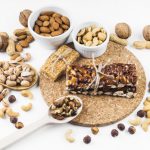Dietary fiber is a unique component of many foods. It has no actual nutrients yet helps ward off a host of diseases and has even been associated with lower body weight.
While women should aim for a minimum of 25 grams a day, and men 38 grams every day, only 5 percent of Americans get enough.
Fruits and vegetables have some fiber, but the highest amounts are in foods traditionally higher in calories — whole grains, legumes and nuts. So it requires a balancing act to get enough fiber while limiting calories for weight loss. In other words, it takes careful menu planning to get close to your ideal number of fiber grams.
One option is to start your day with a high-fiber, whole-grain breakfast like an all-bran cereal — fast and simple. Most brands have 5 grams in one cup, but read package labels so you know for sure.
At lunch, add a half-cup of cooked beans or lentils to a green salad for a very filling 7 or 8 grams. One cup of raspberries has about 8 grams, as do many berries, making them great for a snack or dessert (or on top of that high-fiber breakfast cereal). One cup of broccoli has 5 grams while one cup of acorn squash has 9 grams; both are healthy side dishes.
More nutrient-dense high-fiber foods:
- 1 cup of cooked pearl barley, 6 grams.
- 1 cup chick peas (garbanzo beans), 12 grams.
- 3 cups air-popped popcorn, 3.6 grams.
- 1 medium artichoke, 10.3 grams.
- 1 medium pear, 5.5 grams.
- 1 ounce almonds, 3.5 grams.
Try to eat a fiber-rich item at every meal and snack, and you’ll have an easier time reaching your daily goal.
More information
The U.S. National Institutes of Health has a comprehensive guide to fiber.
Copyright © 2025 HealthDay. All rights reserved.



-300x169.jpg)












